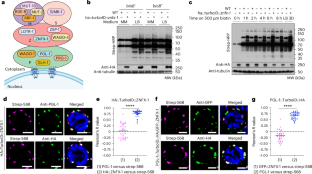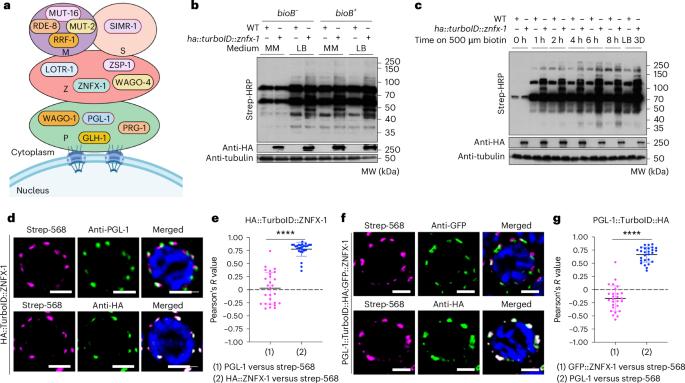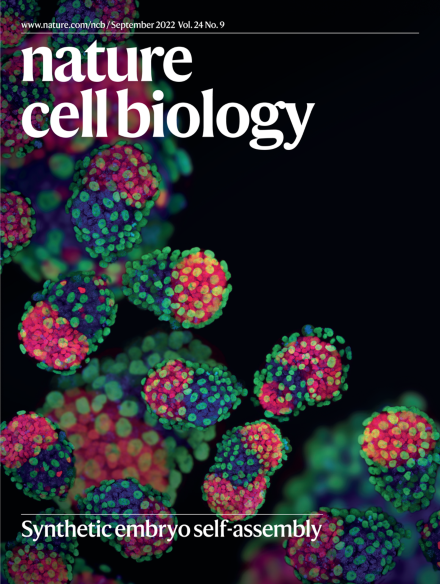HERD-1介导多相凝结物不溶性,调节小核糖核酸驱动的转代表观遗传
IF 17.3
1区 生物学
Q1 CELL BIOLOGY
引用次数: 0
摘要
核仁、应激颗粒/加工体和胚芽颗粒等生物分子凝聚体是多相集合体,其形成机制和意义至今仍鲜为人知。在这里,我们利用优化的 TurboID 介导的近距离生物素标记,鉴定了草履虫胚芽颗粒中时空有序的 P、Z 和 M 多相凝聚体的蛋白质成分。其中包括 462、41 和 86 个分别定位到 P、Z 和 M 凝聚物的蛋白质,其中 522 个是以前未知的蛋白质成分。每种缩聚物的蛋白质都富含不同类别的结构域和内在无序域,这表明它们具有不同的功能和组装机制。通过功能筛选,我们发现了一种胚芽颗粒蛋白 HERD-1,它能阻止 P、Z 和 M 缩合物的混合。HERD-1突变体中的混合与种系小RNA通路的混乱和RNA干扰诱导的基因沉默的表观遗传时间延长有关。使用一种对绿色荧光蛋白具有特异性结合活性的纳米抗体强制混合这些凝聚物成分,也会延长表观遗传的时间。我们认为,积极维持胚芽颗粒的不溶性有助于组织和调节小 RNA 驱动的秀丽隐杆线虫转代表观遗传。本文章由计算机程序翻译,如有差异,请以英文原文为准。


HERD-1 mediates multiphase condensate immiscibility to regulate small RNA-driven transgenerational epigenetic inheritance
Biomolecular condensates, such as the nucleolus, stress granules/processing bodies and germ granules, are multiphase assemblages whose formation mechanisms and significance remain poorly understood. Here we identify protein constituents of the spatiotemporally ordered P, Z and M multiphase condensates in Caenorhabditis elegans germ granules using optimized TurboID-mediated proximity biotin labelling. These include 462, 41 and 86 proteins localizing to P, Z and M condensates, respectively, of which 522 were previously unknown protein constituents. Each condensate’s proteins are enriched for distinct classes of structured and intrinsically disordered domains, suggesting divergent functions and assembly mechanisms. Through a functional screen, we identify a germ granule protein, HERD-1, which prevents the mixing of P, Z and M condensates. Mixing in herd-1 mutants correlates with disorganization of germline small RNA pathways and prolonged epigenetic inheritance of RNA interference-induced gene silencing. Forced mixing of these condensate components using a nanobody with specific binding activity against green fluorescent protein also extends epigenetic inheritance. We propose that active maintenance of germ granule immiscibility helps to organize and regulate small RNA-driven transgenerational epigenetic inheritance in C. elegans. Zhao et al. report that the Z compartment protein HERD-1 regulates transgenerational epigenetic inheritance in Caenorhabditis elegans at least in part by preventing the mixing of germ granule condensates.
求助全文
通过发布文献求助,成功后即可免费获取论文全文。
去求助
来源期刊

Nature Cell Biology
生物-细胞生物学
CiteScore
28.40
自引率
0.90%
发文量
219
审稿时长
3 months
期刊介绍:
Nature Cell Biology, a prestigious journal, upholds a commitment to publishing papers of the highest quality across all areas of cell biology, with a particular focus on elucidating mechanisms underlying fundamental cell biological processes. The journal's broad scope encompasses various areas of interest, including but not limited to:
-Autophagy
-Cancer biology
-Cell adhesion and migration
-Cell cycle and growth
-Cell death
-Chromatin and epigenetics
-Cytoskeletal dynamics
-Developmental biology
-DNA replication and repair
-Mechanisms of human disease
-Mechanobiology
-Membrane traffic and dynamics
-Metabolism
-Nuclear organization and dynamics
-Organelle biology
-Proteolysis and quality control
-RNA biology
-Signal transduction
-Stem cell biology
 求助内容:
求助内容: 应助结果提醒方式:
应助结果提醒方式:


